Students Hone Their Research Skills, Learn From Experts at NGS's 2018 Science & Engineering Fair
Febuary 22, 2018
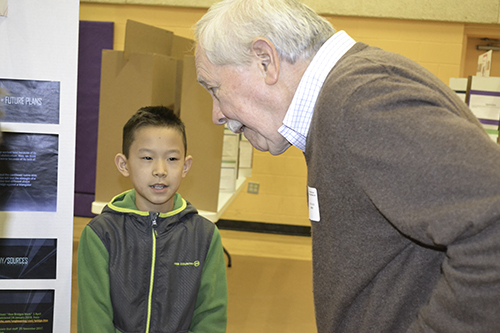
An NGS student presents his research project called, "Collapsed" as Bill Rose of Illinois' Applied Research Institute listens.
It was Friday, February 16th, 2018, the day of “Exploring Our Potential,” the Next Generation School’s (NGS) long-anticipated 2018 Science and Engineering Fair. The students finally got to stand in front of the poster they’d meticulously labored over and present the results of their research to a community expert. But while the experts had been instructed to give students not just positive feedback, but also things they could have done better or could improve upon, no doubt when mom and dad listened to their spiel during the evening session, they got only rave reviews.
Preparing for the fair took a lot of time. First, students had to choose a problem to study. Often it was one relevant to them personally. Then, they’d done a lot of research about their subject. Next, they’d designed and conducted their experiment, and on the day of the fair, they were finally getting to present their research.
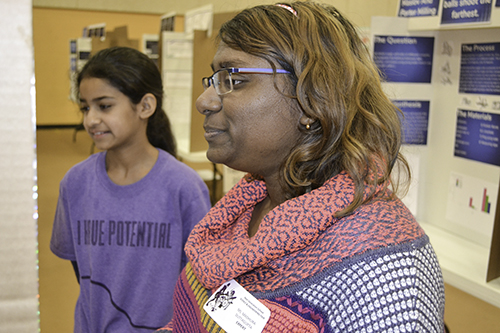
MCB Ph.D. student Madhura Duttagupta (right) listens as an NGS student presents her research.
Unlike science fairs at most schools, NGS’s fair had no official “winner”; each student or team competed to do their personal best and hone their skills in several areas. For example, the goals of the 2018 fair were to help students learn the scientific method, gain a deeper understanding of their research area, learn how to conduct an experiment, plus acquire some useful skills about how to go about presenting research.
But since all the students might not end up in a scientific field doing research, possibly even more important were some real-life skills they gained that they’ll be able to draw upon throughout their lives. For instance, they practiced standing in front of an audience and presenting, interacting with someone they didn’t know, and learned to think on their feet as they responded to questions about their research.
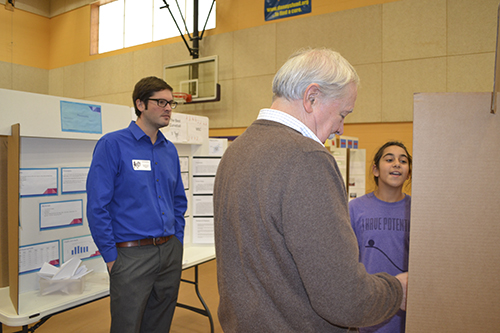
Left to right: Bryant Fritz and Bill Rose listen as an NGS student explains her research.
And according to NGS’ middle school science teacher, Bryant Fritz, the day of the fair wasn’t the first time they’d presented their research to someone. First, they practiced by themselves (and probably to mom and dad). A few days before the fair, they’d practiced in the classroom, and the students had made an outline of the major points that they wanted to make sure that they didn’t forget to say. The day before the fair, they actually got to go down to the gym and see their boards and all the stuff, their artifacts set up on a table. Then they presented to small groups of students in their class, while their classmates wrote down feedback and suggestions about how they could improve.
Although the 2018 fair was pretty similar to what they’d done in the past, according to Fritz, for the students, the fair never gets old.
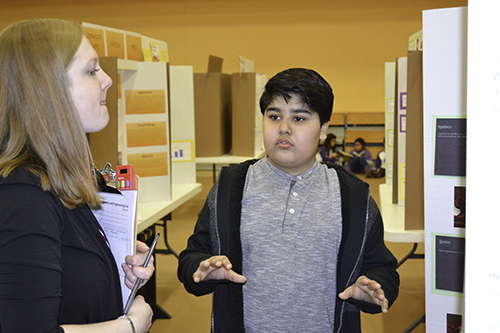 A NGS student presents his research project about "Making Biogas" to Illinois Ph.D. student
A NGS student presents his research project about "Making Biogas" to Illinois Ph.D. student “It's really amazing to see how excited the students are still about doing it,” he says. “And I remember the first day that I introduced that we were going to start working on the process of the science fair. There's always a lot of students, their eyes get really big because they remember past projects that they've done and they remember that it was a really memorable experience for them.”
As in previous years, students could either choose to do an independent project or work with a partner. One thing Fritz found surprising was that even though middle school students tend to be pretty social, a lot fewer had chosen to work with a partner than he expected. “I think the students enjoy kind of being able to take direction by themselves.” They’ve also discovered that working with a partner involves additional challenges, such as figuring out schedules in order to spend extra time testing and working together outside of school.
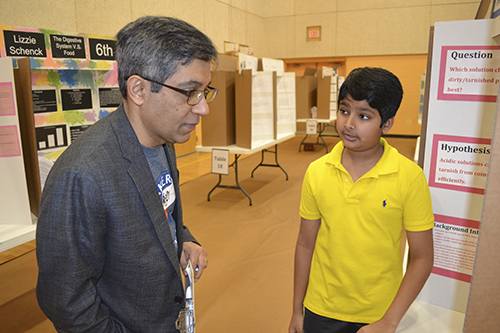
An NGS student explains his project called "Gummy Bear Osmosis" to an expert.
Regarding what topics students would choose, they were encouraged to choose one that was of interest to them personally. For example, several chose topics that had to do with sweets. One experiment, “Sweet Science,” was about baking cookies, as was “The Baking Battle.” Some dealt with a favorite of kids of all ages—candy. One study called “Candy Snap” looked at the brittleness of different candy bars; another “Gummy Bear Osmosis” the results were that while gummy bears would distort and expand, they never completely dissolved—which makes one wonder: “What besides sugar is in gummy bears?” The student researcher suggested that maybe something acidic might have helped, and he should have tried citrus. In their first year in the science fair, all of the 3rd graders did the same study: “Save the Ice Pop!” In other experiments using food, the title said it all, such as in, “Milk to Plastics,” “Making Electricity From Oranges,” and “Coke Explosion.”
Some experiments used salt/sugar, such as, “A Solar-Powered Desalination Experiment.” In “A Race to the Boiling Point,” the student studied whether adding salt or sugar helped water boil faster. In “Cleaning Pennies,” a student who used salt, plus other things readily available in the home, learned that cleaning products comprised of something acidic, specifically vinegar and salt, effectively cleaned tarnish from pennies—something those of us who use make-your-own cleaning products might find useful. Other studies dealt with electronics/engineering, such as “Can You Beat AI at Tic Tac Toe?” and “Phototaxis: Using a Light-Tracking Bristlebot,” and “Lego Brick Bridges.”
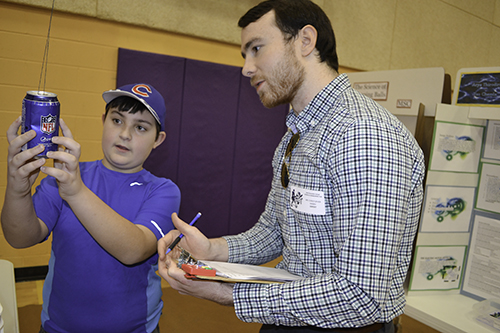 An NGS student presents his research project to Illinois Ph.D. Robotics student Christopher Marry.
An NGS student presents his research project to Illinois Ph.D. Robotics student Christopher Marry.Some of the older students chose topics that have made the news recently. For instance, one eighth grade girl who plays sports was interested in recent research about head injuries. After researching all the latest studies regarding CTE brain disease, she then did a couple of simulations doing some different conditions with eggs. “So she learned a lot from that one,” Says Fritz. “That was a good one.”
Another girl built on last year’s project, a homeless shelter built out of a cardboard box inspired by CU at Home’s One Winter Night, an event where people camp out in shelters in downtown Champaign to raise awareness of Champaign’s homeless community. So this year’s project took last year’s to another level: she built a custom house for her dog, choosing materials to help make it warm in the winter, but cool in the summer. “It was kind of fun to see her picking something that was so personal to her,” says Fritz, “and she's got pictures of her dog and all the dimensions are based on the size of her dog and all these things.”
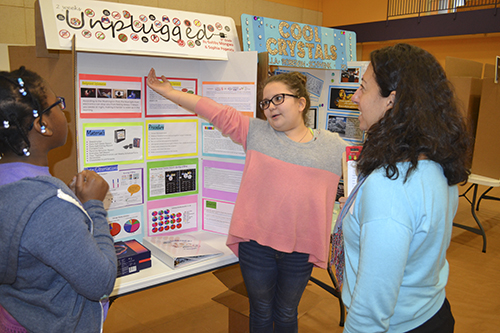 A NGS fifth grader, Sophia (middle) and her partner explain their project "Unplugged" to Psychology instructor Christine Shenouda.
A NGS fifth grader, Sophia (middle) and her partner explain their project "Unplugged" to Psychology instructor Christine Shenouda.This reporter was keen to hear the results of one study which is personally relevant to most of us, “Unplugged,” in which two students compared sleep patterns with and without electronics to determine the impact electronics have on sleep and mood. NGS Head of School Chris Bronowski was particularly excited about this one:
“They have so many wonderful ideas about what they're going to do next,” she explains, “what they should have done with this project. They ran into all of these road blocks...but they have all of these fabulous ideas about what they would do next and how they would modify their research in order to get results that are more accurate.”
As in past years, numerous community experts were on hand to help judge the projects, including several Illinois faculty and PhD students, along with some Next Generation School experts. And as a testament to how valuable and rewarding these experts find the fair, many consider the fair to be a highlight of their year and have come back year after year.
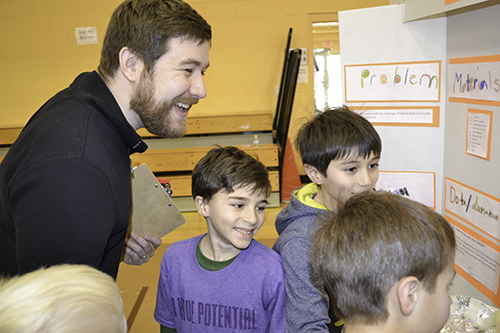
A team of NGS students discuss their science fair project with Illinois PhD student Andrew Sweet (left).
Take Andrew Sweet, a Ph.D Student who’s in PEEC (Program in Ecology, Evolution, and Conservation Biology). Sweet’s research, which he calls “fun most of the time,” is using DNA to look at the evolutionary history of birds and their parasites.
He shares why he keeps coming back: “I love seeing what the kids have been working on. I think it's really exciting to see young ages developing an interest in science and asking questions and critically thinking about ways to test the questions that they have. Coming up with their own studies, working together to come up with their own studies, and then drawing conclusions from what they learned.”
He believes it’s also important that they’re thinking about how they could improve their study in the future, thinking about future experiments they could run or different variables that they could change. “So it's really exciting to see the wheels turn when you ask them a question, and they have some knowledge about what they've been working on, and encouraging them to keep going. So, it's fun to see that.”
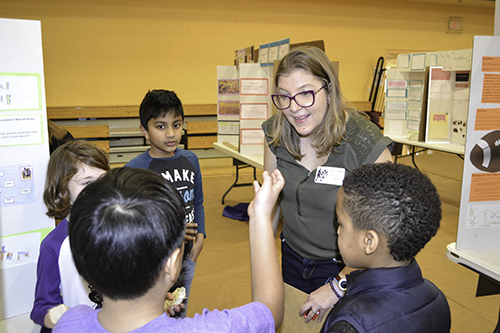
A group of NGS students present their project to Grazi Murad.
NGS Preschool science teacher Grazi Murad, in her 2nd year at the school but her first time on the expert team, says she enjoyed it tremendously.
“I'm so proud of the children and their projects,” she says. “They know everything about the project, and they're having so much fun, and they've been telling me the interesting things that they're learning. They’re really excited to share with me all the things they've learned. It is really nice: I can see all my preschoolers and how much they have learned.”
According to Gretchen Adams, Applied Health Sciences Assistant Dean and a regular at the fair, she keeps coming back year after year because of the students’ excitement about the research.
“Because it's so great to see the curiosity in the kids and that they try to develop a method to try to answer their questions. And I enjoy most that I can tell they’re doing it. So they’re coming up with the questions, and they’re trying to go through and follow the scientific method to try to come to an answer, and I love that, ‘cause it shows me kind of what they’re thinking, and how they’re going through it. So that’s why I keep coming back. Their enthusiasm makes me kind of want to keep seeing what they’re doing.”
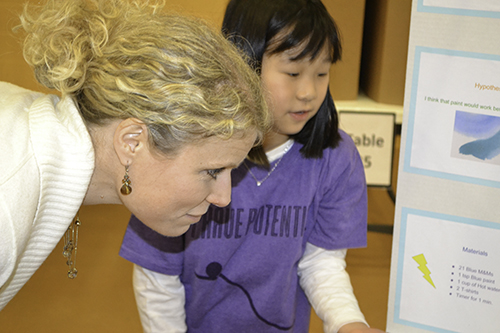
Applied Health Sciences Assistant Dean Gretchen Adams listens as an NGS student presents her research.
Does she see any future chemists? “Oh, absolutely! For sure. Yes, I see all kinds of budding scientists here. In fact, on this person’s sheet, I just said, “Way to go! You’re a budding scientist!”
Head of School Chris Bronowski acknowledges that for the school staff, the kids, and their families put a great deal of time and energy into the fair. “There's a lot of work that goes into it,” she admits. But she also believes the pros far outweigh the cons.
“I think there's always those moments for families, for children, for us, we question ‘Why are we doing this?" But then you see the end product, and you see everything that they've learned and all of the skills that they've learned as they've gone through the project, and that's what makes us keep going year after year with it.”
Bronowski shares an anecdote about the fair’s impact on students. “I ran into a former student at the grocery store a few weeks ago, and we were laughing about one of his middle school projects that had kind of a funny mishap, and then how he had kind of fixed it and moved on. But those things stick with children for so long. He's in college now but it sticks with him that he was able to figure that out and move on, and I think it struck me that's really so powerful and profound.”
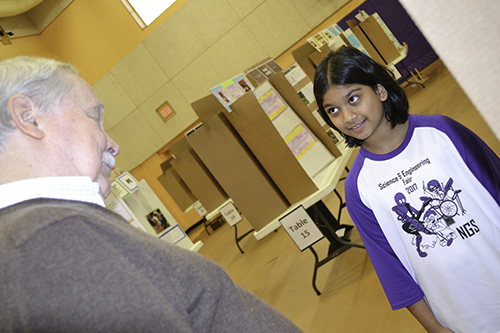
NGS student Praachi Mudar presents her research to Bill Rose of Illinois' Applied Research Institute.
What’s the hardest thing about the Fair for the kids? “When you present,” says fifth grader Yahyah, “I think the background research is the hardest. Because it’d be bad to look at your board and keep on reading the whole time. So in background research, you have to memorize most of it.”
A fifth grader, Sophia, whose research was on, “Do electronics affect sleep?” reports that her favorite part of the fair is when her poster is finally finished! “I really like the satisfaction of when you’re done, because it’s a lot of hard work. And then when you’re finally done, you get to relax. So the board looks really nice when you’re done, and that’s my favorite part.”
Despite the huge amount of work doing the fair entails, Bronowski is already looking forward to next year: “Tomorrow we'll start planning for next year's fair and talking about the things that we want to do differently, and other things that we could add or change to make it better.”
More: 6-8 Outreach, K-6 Outreach, Next Generation School, Science Fair, 2018
For additional I-STEM articles highlighting Next Generation School's partnership with the University of Illinois, see the following:
- At NGS' Science & Engineering Fair 2017, Every Student Is a Winner!
- 2016 NGS Science & Engineering Fair Fosters Research/Presenting to Experts
- 2015 NGS Science & Engineering Fair Called the "Most Successful" Ever
- Next Generation School's Science and Engineering Fair: Every Student Is a Winner
- Next Generation School Fair: Tomorrow's Scientists & Engineers Meet Today's
- Local Teacher Uses Project Lead the Way to Prepare Next Generation of Engineers
- MechSE Gives Back to the Community
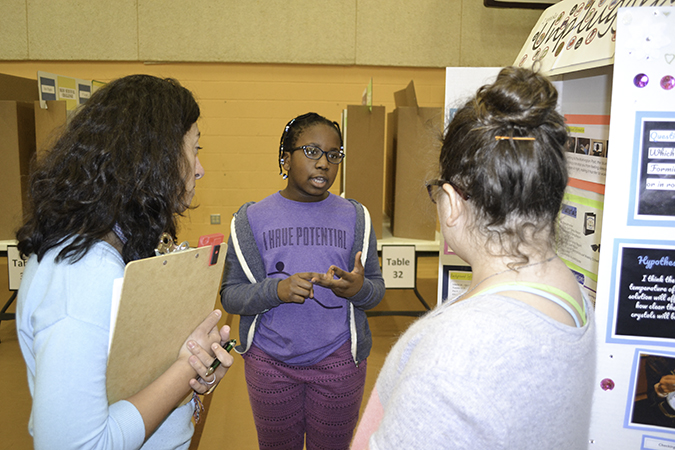
An NGS student explains how her and her partner's "Unplugged" project worked to Illinois Psychology instructor Christine Shenouda.













.jpg)
















